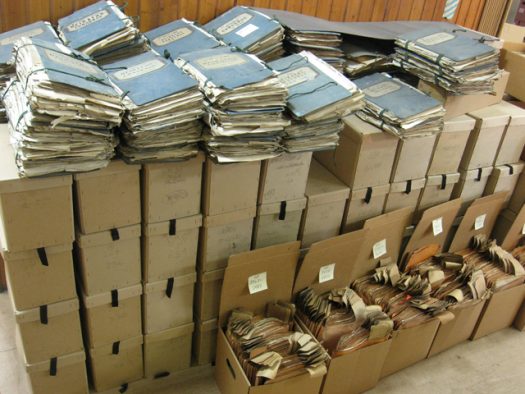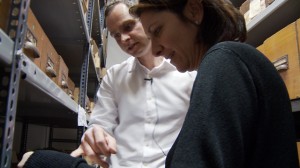
I was planning to write a simple, one-post response to the film Auf Wiedersehen: ‘Til We Meet Again, the story of a visit to Austria of three generations of a family with Viennese roots. But the more I wrote, the more I had to say. Since I viewed the film three times, I suppose there’s a certain symmetry to a three-post response.
In Part 1, I detailed my initial emotional response to the film, marveling at how the reactions of the mother and aunt of filmmaker Linda Mills to their childhood home, Vienna, mirrored those of my own mother.
In Part 2, I talked about the historical context I gained for my mother’s past. In learning how the Nazis divested all the Austrian Jews of their money and property before they would allow them to leave, I understood for the first time why my mother came to America on her own.
Here I will discuss…
The Lost Archive of the Jewish Community Vienna

I don’t have to explain to the genealogically oriented how exciting it is to find a cache of papers; this is a crowd that went wild when the 1940 Census was put on line.
But several things make the archives discovered in a vacant building in Vienna particularly interesting:
- Many of the records are from the era of the Holocaust (1938 to 1945) and were kept by the Israelitische Kultusgemeinde Wien (IKG; Jewish Community Vienna) because it was the Jewish community that was put in charge of collecting money for the Nazis
- The records were lost for 55 years and only re-discovered in 2000.
- There are half a million of them.
As described on the United States Holocaust Memorial Museum website:
During a routine inspection in 2000 of one of its older buildings, IKG officials found a vacant apartment filled with documents in wooden cabinets and 800 cardboard boxes, covered with decades of dirt, dust, and mold. Closer examination revealed that these materials included a cache of approximately 500,000 Holocaust-era pages of reports, letters, emigration and financial documents, deportation lists, card files, books, photographs, maps, and charts detailing the final years of the once-largest German-speaking Jewish community in Europe and representing a substantial and long-forgotten part of the archive of the Viennese Jewish community.
Though it is fascinating — and tempting — I’m not going to explore in great depth the topic of Nazi money collection being consigned to the Jewish community. Historian Doron Rabinivoci, mentioned in Part II, wrote an entire book on the subject, Eichmann’s Jews: The Jewish Administration of Holocaust Vienna, 1938-1945. Suffice it to say, it’s complicated. Jews were set against other Jews, but the Jewish administrators — some 900 of them — also managed to save two-thirds of Austria’s Jewish community.
And during this period, they created questionnaires relating to immigration and welfare that were of great historical importance. In a piece about the archives on NPR in 2007, Paul Shapiro of the U.S. Holocaust Museum says that “for the 118,000 who did escape, these records turned upside down the whole field of Holocaust studies.”
He notes:
It’s often asked why did these Jewish communities go like lambs to the slaughter because we’re often confronted with photographs of people who have already been starved, who have been stripped off their dignity, who are literally at the doors of the gas chambers. In this kind of documentary record, you have a snapshot of the Jewish community of Vienna in its full diversity. You know who the people were. These are not names and people who were lost. You also see the systematic effort of the community to help Jews escape.
So what does this have to do with the film “Auf Wiedersehen?” you may be wondering.
The Archivist and the Researcher(s)
Lothar Hoelbling was one of the discoverers of the archives and the chief archivist of the Jewish Community Vienna. It is to Lothar that Linda turns to find information on her family members. Several of the scenes of the film are shot in the archives.

Lothar is not Jewish; indeed, his grandfather was a Nazi. You don’t get the sense that he is tormented by his past, however. “My grandfather died when I was five,” he says. At the same time, it is clear that his past has been an impetus to work as a historian.
And perhaps for his extreme helpfulness to the victims and their families. I speak here from personal experience.
I’ve mentioned before that I met Linda in New York before I started this blog. When I launched it last August, I sent her a link and asked her to pass it along to Lothar, because I thought the archives might be important to my research.
Unfettered access to the archives has become complicated, it turns out. Unfettered access to the archivist, on the other hand — not in a stalky way, I promise — has been very uncomplicated.
Lothar has explained the locations of all the documents that have been microfilmed, sending links to records of marriages, to Vienna address books, even to a film of Nazi propaganda against the Jews that I can’t bear to watch (I had asked him a question about whether the blood libel against the Jews might have been used against my family members who were butchers; the film gives a definitive “yes” answer). He has answered every email promptly and in great detail.
This post is, in part, a huge thank you to him.
Of course, I have more questions for him. It’s occurred to me that a document reproduced in the Freud Museum catalog of the “Freud’s Lost Neighbors” exhibition, detailing the divestment of assets of Siegmund Kornmehl, Freud’s butcher, must have been based on Jewish Community Vienna records. (Note: The excellent translation of this document was done by Susannah Kemple, who is the reason I know Linda Mills in the first place, but that’s a longish story.)
I don’t understand all the references. The document says, for example, that
The kosher butcher shop of Siegmund Kornmehl (1868-1942) was a thriving business: with the main storefront at 19 Berggasse and two other branches nearby, it was one of the most important providers of Jewish care-related services in interwar Vienna, along with the Hospital and Home for the Aged run by the Jewish Community of Vienna.
How might a butcher shop provide Jewish care-related services?
Happily for me, if not for the Jewish Community Vienna, Lothar is now working with Linda Mills at the Center on Violence & Recovery at NYU, where I plan to visit with him next week when I go to New York. I will be able to thank him in person for all his help — and ask him more questions.
Be prepared, Lothar!

Goosebumps all over. Hope you get some sleep during your New York visit!
Ha! The archives are still in Vienna — only the archivist is in New York. If I don’t sleep on my trip it’s because it will be for taking advantage of seeing friends, etc. Those late night archival searches will (for the time being) still take place on line.
Thanks for coming by, Kay.
This bowls me over. A history-changing discovery. They saved two-thirds of Austria’s Jewish community! The Nazis tried to co-opt the Jews, and even made them collectors of money for Nazis, but the Jewish administrators were too smart for them. This is bigger news than Schindler’s list.
I wish for you a fruitful meeting with Lothar, so that you can uncover more of the story. Don’t you love the way history keeps popping up again in lost documents (and corpses under parking lots) so that we have to revise our views?? (This happened with the early Dutch settlements in NY–troves of documents–resulting in the book, “The Island at the Center of the World.”
James Joyce famously recommended “silence, exile, and cunning.” I look forward to stories of Jewish people outsmarting the Nazi bullies.
It’s funny, I hadn’t thought of it in terms of outsmarting — I just thought they did the best they could in a terrible situation — but you’re right. They did save a lot of lives although at that point they couldn’t have known what was in store for those who weren’t saved.
Thank you for your good wishes and for your always thoughtful comments. I’m enjoying the conversation.
Linda’s aunt (my mom) is still sharp. She also has a friend in Florida who was a kindertransport survivor.
That’s great to hear. Thanks so much for coming here and commenting.